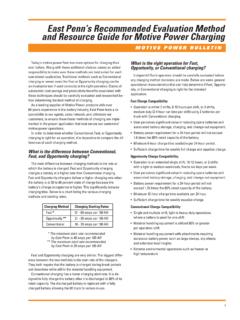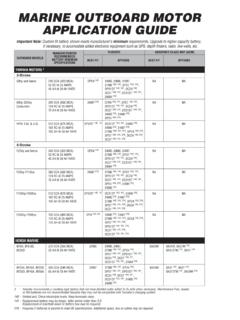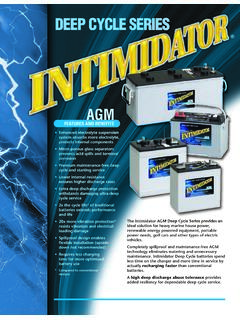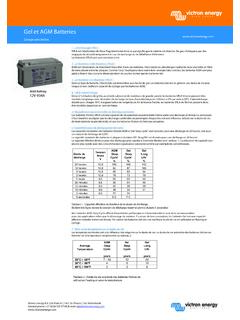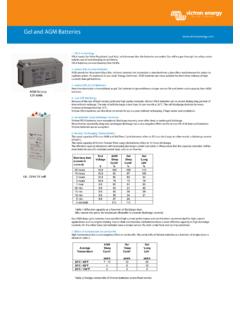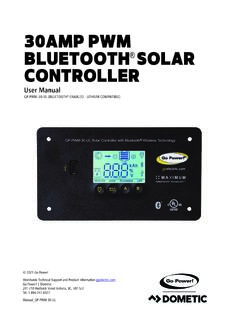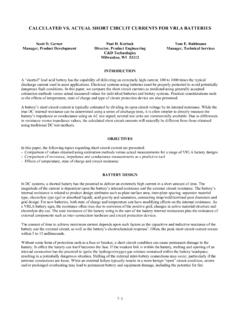Transcription of Basic Rules for Battery Care & Maintenance
1 SAFETY Proposition 65 Warning: batteries , Battery posts,terminals and related accessories contain lead and lead compounds, and other chemicals known to the state ofCalifornia to cause cancer, birth defects and reproductiveharm. Wash hands after handling!Warning:Follow all safety instructions when handling batteries ! Always wear safety glasses and a face shield whenworking on or near batteries generate explosive hydrogen gas. Keep sparks, flames and cigarettes away from batteries at all times. Do notconnect or disconnect live circuits. To avoid creatingsparks, always turn charging and testing equipment off beforeattaching or removing clamps. ALWAYS DISCONNECT GROUNDED CABLE FIRST AND CONNECT IT LAST TO PREVENT DANGEROUS all work in a well ventilated area.
2 Never lean directlyover a Battery while boosting, testing or charging it. PROTECT YOUR EYES! batteries contain corrosive sulfuric acid that can destroy clothing and burn the skin. Neutralize acid spills with a pastemade of baking soda and water or large quantities of water. BE CAREFUL!.IN-VEHICLE SERVICE AND safety precautions:WEAR PROPER EYE PROTECTION!Prior to any testing, visually inspect the Battery . Look for: Cracked or broken case or cover Loose cable connections Leaking case-to-cover seal Corrosion Damaged or leaking terminalsNeutralize any corrosion with a baking soda/water paste or Battery cleaner spray. Scrape or brush off the residue andwash the area with clean water.
3 Following your visualinspection, check the Battery s state of charge with a must boost charge a weak Battery before load testing. (See charging chart under Charging Tips section.) If fully charged, perform a load test. PROTECT YOUR EYES! Basic Rules for Battery Care & MaintenanceALWAYSWEAR EYE PROTECTION WHEN WORKING AROUND batteries !.DRY CHARGE PROPER EYE PROTECTION! Fill each cell to proper level with Battery -grade sulfuric acid of specific gravity. Battery and acid must be at a temperature of 60 F to 100 F (16 C to 38 C) at time of filling. Boost charge 12V batteries at 15 amps until specific gravityis or higher and the electrolyte temperature is at least60 F ( C). BOTH CONDITIONS MUST BE MET.
4 (Boost charge 6V and 12V heavy-duty batteries at 30 amps.) If violent gassing or spewing occurs, reduce charge rate. After charging, check electrolyte levels. If required, add additional electrolyte to bring all levels to the bottom of the vent wells. DO NOT OVERFILL. If the Battery requires top-off while in service, add distilled NOT ADD ACID..SAFE safety precautions:WEAR PROPER EYE PROTECTION! Before removing old Battery , mark the positive (+) and negative ( ) cables for proper connection to the new Battery . Always disconnect the ground cable first [usually negative ( )] to avoid any sparking around Battery . Then disconnect the positive (+) cable and carefully remove the old Battery .
5 Clean and inspect. If necessary, repaint or replace the tray, hold-down and/or Battery cables. Cable ends must be clean and corrosion free. Cable must not be frayed or bare. Put corrosion protection washers on Battery terminals. Install new Battery in same position as old one and tighten hold-down. Be sure terminals will clear hood, fender, box lid, etc. to avoid vehicle damage and/or explosion. Connect positive (+) cable first. Connect ground cable last. If side terminal connection, use a special side terminal torque tool to tighten side terminal cables to avoid damage. Never overtighten or hammer cables onto terminals. Coat terminals and cable connection with a corrosion protection THE CHARGING voltage regulator should be checked every 10,000 miles or every time you change oil.
6 It should be checked immediate-ly if the Battery is hot to the touch, if electrolyte is bubbling orspewing from the vents, if your hydrometer reading is or above , or if the open circuit voltage is volts or above volts. Overcharging is evident byexcessive water consumption and/or spewing or bubbling ofelectrolyte out of the vents. Undercharging is evident by slowcranking or lights dimming at !KEEP OUT OF THE REACH OF NOT TIP. KEEP VENT CAPS TIGHT AND NOT OPEN FLUSH COVER BLINDNESSOR SPARKS FLAMES SMOKINGSULFURICACIDCAN CAUSEBLINDNESS ORSEVERE EYESIMMEDIATELYWITH safety precautions:WEAR PROPER EYE PROTECTION!First perform an open circuit voltage test, then an adjustable load test.
7 A load test is the best way to determine if the Battery is delivering adequate electrical performance. Makesure your variable load tester is working properly. You can't load test a discharged the voltage is below , be sure to completely charge it before continuing. Refer to the charging chart under Charging Tips section for important information. To avoid sparking and explosive gasses, be sure load tester is OFF and Battery is disconnected before hook-up. Use computer memory saver to retain the vehicle s electronic memory while the Battery is disconnected. Connect the positive (+) tester clamp to the positive (+) Battery terminal. Then connect the negative ( ) tester clamp to the negative ( ) Battery terminal.
8 Always protect your eyes. Set the tester for one-half the Battery s 0 F cold crank rating and apply the load for 15 seconds. (If the CCA rating is unknown, use 1/2 of the minimum Battery CCA requirement of the vehicle.) Estimate the internal temperature of the Battery to the nearest 10 F. Apply the load for 15 seconds. Note the voltage at 15 seconds with the load on and immediately shut the load off. A reading at least equal to the value from the chart below indicates a good BATTERY6-VOLT BATTERY70 F (21 C) or F (16 C) F (10 C) F (4 C) F (-1 C) F (-6 C) F (-12 C) F (-18 C) If the Battery did not meet the required voltage and if it was not charged in Step 1, completely recharge the Battery and repeat the test.
9 If it still fails to meet requirements, replace the safety precautions: WEAR PROPER EYE PROTECTION!Conductance uses the Battery s response to a very small signal in an attempt to predict the effects of a much largercurrent. Conductance testing is ineffective on a dischargedbattery. If the Battery is known to be discharged or if thetester tells the operator to charge before testing again, thebattery must be completely recharged. It may not be required to turn a conductance tester off or on. If off, you must turn on immediately when connected to a Battery . Most will turn off automatically if ignored long enough. Some have no Battery of their own and get all theirpower from the Battery being tested.
10 Connect the positive (+) tester clamp to the positive (+) Battery terminal. Then connect the negative ( ) tester clamp to the negative ( ) Battery terminal. If the Battery has more than one pair of terminals ( top posts and side terminals) always perform the testing on the terminals that are used in the vehicle. Use the proper charging adapters for stud or side terminal batteries . Never connect tester to a bolt or stud. Turn on if needed. Enter the requested information. Be sure to distinguish between a CCA rating and a CA or MCA rating. If no rating is available, use the minimum Battery CCA requirement of the vehicle. If the tester says to replace a Battery that was tested in the vehicle, repeat the testing after removing the cables and cleaning the THE STATE OF are two styles of mainte-nance-free typesand accessible maintainable types withremovable vent adding water to a maintainable Battery , take an opencircuit voltage reading and/or hydrometer reading of one a different cell each time.

